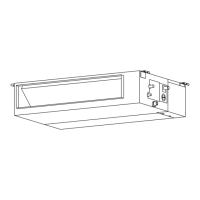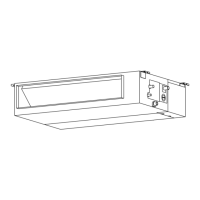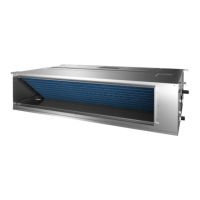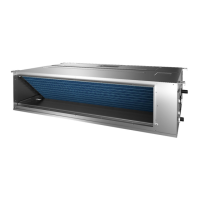Vacuum Drying and Leakage Checking
Installation 227
shall cause shutdown of unit. When this situation happens, the normal startup only can be recovered by
turning down power supply and eliminating accumulated water.
Note: Drain plug at the main water-containing plate is used for eliminating accumulated water in
water-containing plate when maintaining air conditioner fault. During normal operation, the plug shall be
filled in to prevent leakage.
6.4 Insulation work of drainage pipe
Refer the introduction to the insulation engineering parts.
7. Vacuum Drying and Leakage Checking
7.1 Purpose of vacuum drying
Eliminating moisture in system to prevent the phenomena of ice-blockage and copper oxidation.
Ice-blockage shall cause abnormal operation of system, while copper oxide shall damage compressor.
Eliminating the non-condensable gas (air) in system to prevent the components oxidizing, pressure
fluctuation and bad heat exchange during the operation of system.
7.2 Selection of vacuum pump
The ultimate vacuum degree of vacuum pump shall be -756mmHg or above.
Precision of vacuum pump shall reach 0.02mmHg or above.
7.3 Operation procedure for vacuum drying
Due to different construction environment, two kinds of vacuum drying ways could be chosen, namely
ordinary vacuum drying and special vacuum drying.
7.3.1 Ordinary vacuum drying
1. When conduct first vacuum drying, connect pressure gauge to the infusing mouth of gas pipe and liquid
pipe, and keep vacuum pump running for 1hour (vacuum degree of vacuum pump shall be reached
-755mmHg).
2 If the vacuum degree of vacuum pump could not reach -755mmHg after 1 hour of drying, it indicates
that there is moisture or leakage in pipeline system and need to go on with drying for half an hour.
3 If the vacuum degree of vacuum pump still could not reach -755mmHg after 1.5 hours of drying, check
whether there is leakage source.
4 Leakage test: After the vacuum degree reaches -755mmHg, stop vacuum drying and keep the pressure
for 1 hour. If the indicator of vacuum gauge does not go up, it is qualified. If going up, it indicates that
there is moisture or leak source.
7.3.2 Special vacuum drying
The special vacuum drying method shall be adopted when:
1. Finding moisture during flushing refrigerant pipe.
2. Conducting construction on rainy day, because rain water might penetrated into pipeline.
3. Construction period is long, and rain water might penetrated into pipeline.
4. Rain water might penetrate into pipeline during construction.
Procedures of special vacuum drying are as follows:
1. Vacuum drying for 1 hour.
2. Vacuum damage, filling nitrogen to reach 0.5Kgf/cm2 .
Because nitrogen is dry gas, vacuum damage could achieve the effect of vacuum drying, but this
method could not achieve drying thoroughly when there is too much moisture. Therefore, special
attention shall be drawn to prevent the entering of water and the formation of condensate water.
3. Vacuum drying again for half an hour.
If the pressure reached -755mmHg, start to pressure leakage test. If it can not reached the value,
repeat vacuum damage and vacuum drying again for 1 hour.

